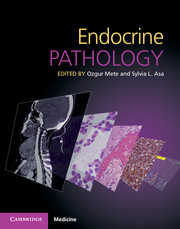Book contents
- Endocrine Pathology
- Endocrine Pathology
- Copyright page
- Contents
- Acknowledgements
- Contributors
- Preface
- Section I Clinical approaches
- Section II Investigative techniques
- Section III Anatomical endocrine pathology
- Chapter 11 The brain as an endocrine organ (including the pineal gland)
- Chapter 12 The pituitary gland
- Chapter 13 Thyroid
- Chapter 14 Parathyroid gland
- Chapter 15 Adrenal cortex
- Chapter 16 Adrenal medulla and extra-adrenal paraganglia
- Chapter 17 Endocrine lesions of the gastrointestinal tract
- Chapter 18 The endocrine pancreas
- Chapter 19 Liver in endocrine disease
- Chapter 20 Pulmonary, thymic, and mediastinal neuroendocrine lesions
- Chapter 21 The kidney in endocrine disease
- Chapter 22 Endocrine aspects of the male genitourinary system
- Chapter 23 Endocrine lesions in the mammary gland
- Chapter 24 The placenta
- Chapter 25 The gynecological tract: neuroendocrine tumors and ovarian tumors with endocrine association
- Chapter 26 Skin manifestations in endocrine diseases
- Chapter 27 Cardiovascular system in endocrine disease
- Chapter 28 Soft tissue in endocrine disease
- Chapter 29 Bone in endocrine disease
- Chapter 30 The approach to metastatic endocrine tumors of unknown primary site
- Index
- References
Chapter 22 - Endocrine aspects of the male genitourinary system
from Section III - Anatomical endocrine pathology
Published online by Cambridge University Press: 13 April 2017
- Endocrine Pathology
- Endocrine Pathology
- Copyright page
- Contents
- Acknowledgements
- Contributors
- Preface
- Section I Clinical approaches
- Section II Investigative techniques
- Section III Anatomical endocrine pathology
- Chapter 11 The brain as an endocrine organ (including the pineal gland)
- Chapter 12 The pituitary gland
- Chapter 13 Thyroid
- Chapter 14 Parathyroid gland
- Chapter 15 Adrenal cortex
- Chapter 16 Adrenal medulla and extra-adrenal paraganglia
- Chapter 17 Endocrine lesions of the gastrointestinal tract
- Chapter 18 The endocrine pancreas
- Chapter 19 Liver in endocrine disease
- Chapter 20 Pulmonary, thymic, and mediastinal neuroendocrine lesions
- Chapter 21 The kidney in endocrine disease
- Chapter 22 Endocrine aspects of the male genitourinary system
- Chapter 23 Endocrine lesions in the mammary gland
- Chapter 24 The placenta
- Chapter 25 The gynecological tract: neuroendocrine tumors and ovarian tumors with endocrine association
- Chapter 26 Skin manifestations in endocrine diseases
- Chapter 27 Cardiovascular system in endocrine disease
- Chapter 28 Soft tissue in endocrine disease
- Chapter 29 Bone in endocrine disease
- Chapter 30 The approach to metastatic endocrine tumors of unknown primary site
- Index
- References
- Type
- Chapter
- Information
- Endocrine Pathology , pp. 834 - 857Publisher: Cambridge University PressPrint publication year: 2000



